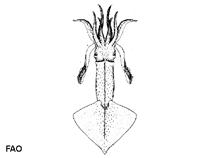Onychoteuthis banksii (Leach, 1817)
Hooked squid| Native range | All suitable habitat | Point map | Year 2050 |

|
| This map was computer-generated and has not yet been reviewed. |
| Onychoteuthis banksii AquaMaps Data sources: GBIF OBIS |
Classification / Names Common names | Synonyms | CoL | ITIS | WoRMS
Cephalopoda | Oegopsida | Onychoteuthidae
Environment: milieu / climate zone / depth range / distribution range Ecology
Pelagic; depth range 0 - 800 m (Ref. 275). Tropical; 70°N - 44°S, 180°W - 180°E (Ref. 97142)
Distribution Countries | FAO areas | Ecosystems | Occurrences | Introductions
Circumglobal in warm and temperate oceanic waters.
Length at first maturity / Size / Weight / Age
Maturity: Lm ? range ? - ? cm Max length : 37.0 cm ML male/unsexed; (Ref. 97142)
Also caught using jigs (Ref. 417) and dip nets (Ref. 275). Medium-sized squid; mantle length up to 300 mm (370 mm only in the northern Pacific Ocean, Nesis 1982, 1987) (Ref. 97142). Oceanic, eurythermal, meso- and epipelagic species that occurs from the surface to 150 m depth and as deep as 4, 000 m. A schooling species frequently observed "flying" above the surface to escape predators in pursuit. Very dense muscular structure and high respiration rates confirm it is a fast-swimming, slow-growing species. Paralarvae are abundant in the eastern Atlantic Ocean, particularly from January to March. Spent females have severely degenerated muscular tissue of head, mantle, fins, as well as missing tentacles, so that they appear almost gelatinous. Prey consists of fishes and squids. Predators include giant red shrimp, fishes, e.g. albacore, yellowfin tuna, lancetfish, swordfish, tiger shark, smooth hammerhead shark, spinner, Frasier’s striped and Risso’s dolphins, toothed whales and fur seals (Ref. 97142).
Life cycle and mating behavior Maturity | Reproduction | Spawning | Eggs | Fecundity | Larvae
Males mature earlier than females; synchronous oocyte development with high fecundity, i.e., more or less 200,000 eggs (Ref. 97142).
Main reference
References | Coordinator | Collaborators
Roper, C.F.E., M.J. Sweeney and C.E. Nauen. 1984. (Ref. 275)
IUCN Red List Status
(Ref. 130435: Version 2024-2)
Data deficient (DD) ; Date assessed: 11 May 2010
CITES status (Ref. 108899)
Not Evaluated
CMS (Ref. 116361)
Not Evaluated
Threat to humans
Human uses
Fisheries: of potential interest
| FishSource |
Tools
More information
Trophic Ecology
Ecology
Population dynamics
Growth
Max. ages / sizes
Length-weight rel.
Length-length rel.
Length-frequencies
Mass conversion
Recruitment
Abundance
Max. ages / sizes
Length-weight rel.
Length-length rel.
Length-frequencies
Mass conversion
Recruitment
Abundance
Life cycle
Distribution
Human Related
Aquaculture profiles
Stamps, coins, misc.
Stamps, coins, misc.
Outreach
Taxonomy
References
Internet sources
BHL | BOLD Systems | CISTI | DiscoverLife | FAO(Publication : search) | Fishipedia | GenBank (genome, nucleotide) | GloBI | Gomexsi | Google Books | Google Scholar | Google | PubMed | Tree of Life | Wikipedia (Go, Search) | Zoological Record
Estimates based on models
Preferred temperature
(Ref. 115969): 7.6 - 23, mean 14.3 (based on 1813 cells).



